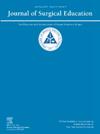ACGME合并后外科住院医师和奖学金匹配的变化
IF 2.6
3区 医学
Q1 EDUCATION, SCIENTIFIC DISCIPLINES
引用次数: 0
摘要
2015年,研究生医学教育认证委员会(ACGME)、美国骨科协会(AOA)和美国骨科医学院协会(AACOM)之间开始过渡,导致2020年住院医师和奖学金的单一认证机构。本研究旨在阐明这是否会影响整骨疗法学生与普通外科住院医师、综合外科住院医师和外科奖学金的匹配。设计、设置和参与者使用结果和数据住院医师匹配数据文件和结果和数据:来自2015年至2024年国家住院医师匹配计划的专业匹配服务数据,分别提取了骨科和对抗疗法与普通外科住院医师和外科奖学金的匹配率数据。申请人在2015-2019年(合并前)或2020-2024年(合并后)进行匹配分组。采用卡方检验进行统计分析,以确定合并前后组的平均配对次数是否有显著差异(p <;0.05)。结果合并后,骨科学生匹配入普外科住院医师的比例显著增加(DO, 5.77% vs 14.25%, p = 0.032)。然而,与胸外科、整形外科和胸外科等综合住院医师相匹配的整骨疗法学生比例没有增加(p >;0.05)。对于外科奖学金,骨病学生的匹配比例没有显著增加(DO, 6.36% vs 9.59%, p = 0.389)。独立地,整骨疗法配对在不同的奖学金中有所增加;然而,仅在血管(8.16% vs 14.17%, p = 0.013)和手外科(3.79% vs 5.86%, p = 0.019)方面具有显著性。结论合并后,骨科学生和医师填补普外科住院医师、血管外科和手外科研究员职位的人数有所增加。然而,与综合外科住院医师相匹配的整骨疗法学生的比例保持不变。本文章由计算机程序翻译,如有差异,请以英文原文为准。
Changes in Matches into Surgical Residencies and Fellowships Following the ACGME Merger
Objective
In 2015, a transition was initiated among the Accreditation Council for Graduate Medical Education (ACGME), American Osteopathic Association (AOA), and American Association of Colleges of Osteopathic Medicine (AACOM), resulting in a single accrediting body for residencies and fellowships as of 2020. This study aims to elucidate whether this had an impact on osteopathic students' matching into general surgery residencies, integrated surgery residencies, and surgical fellowships.
Design, Setting, and Participants
Using the Results and Data Residency Match data file and the Results and Data: Specialties Matching Service data from the National Resident Matching Program from 2015 to 2024, data was extracted regarding osteopathic and allopathic match rates into general surgery residency and surgical fellowships, respectively. Applicants were grouped on matching in 2015-2019 (premerger) or 2020-2024 (postmerger). Statistical analysis using the Chi-Square test was performed to determine if there was a significant difference in the mean number of matches in the pre and postmerger groups (p < 0.05).
Results
Postmerger, the proportion of osteopathic students matching into general surgery residency increased significantly (DO, 5.77% vs 14.25%, p = 0.032). However, the proportion of osteopathic students who matched into integrated residencies, such as thoracic, plastic, and thoracic surgery, did not increase (p > 0.05). For surgical fellowships, there was no significant increase in the proportion of osteopathic students matching (DO, 6.36% vs 9.59%, p = 0.389). Independently, an increase was seen in osteopathic matches across fellowships; however, it was only significant for vascular (8.16% vs 14.17%, p = 0.013) and hand surgery (3.79% vs 5.86%, p = 0.019).
Conclusions
Postmerger, there was an increase in osteopathic students and physicians filling general surgery residency, vascular, and hand surgery fellowship positions. However, the proportion of osteopathic students who matched into integrated surgery residencies remained the same.
求助全文
通过发布文献求助,成功后即可免费获取论文全文。
去求助
来源期刊

Journal of Surgical Education
EDUCATION, SCIENTIFIC DISCIPLINES-SURGERY
CiteScore
5.60
自引率
10.30%
发文量
261
审稿时长
48 days
期刊介绍:
The Journal of Surgical Education (JSE) is dedicated to advancing the field of surgical education through original research. The journal publishes research articles in all surgical disciplines on topics relative to the education of surgical students, residents, and fellows, as well as practicing surgeons. Our readers look to JSE for timely, innovative research findings from the international surgical education community. As the official journal of the Association of Program Directors in Surgery (APDS), JSE publishes the proceedings of the annual APDS meeting held during Surgery Education Week.
 求助内容:
求助内容: 应助结果提醒方式:
应助结果提醒方式:


